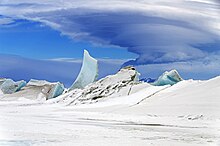Scott Base
It was named in honour of Captain Robert Falcon Scott, RN, leader of two British expeditions to the Ross Sea area of Antarctica.
Scott Base was originally constructed in support of the UK inspired and privately managed Commonwealth Trans-Antarctic Expedition (TAE).
The New Zealand government provided support for the TAE and also for the International Geophysical Year (IGY) project of 1957, five of whose members were attached to the Expedition.
In February 1956, 10 months before the TAE and IGY parties were due to head to the Antarctic, Frank Ponder, an architect at the Ministry of Works (New Zealand), was given the task of designing the base.
Three New Zealand observers who were also given the task of selecting the site for a base went to McMurdo Sound with the United States "Operation Deep Freeze I" in the summer of 1955.
This was later changed to Pram Point as it provided better access for offloading supplies from the Expedition ship HMNZS Endeavour and also allowed for the operation of the critical RNZAF Antarctic Flight on a nearby ice runway.
Scott Base passed over to New Zealand Government ownership via the Department of Scientific and Industrial Research (DSIR), on 5 March 1958, at the conclusion of the TAE.
[10] On 5 November 2021, Antarctica New Zealand confirmed that PrimePort Timaru will host the redevelopment of the prefabricated Scott Base facilities.
Spark NZ also provide phone services to McMurdo for calls to New Zealand as well as to the Italian Programme at Terra Nova Bay.
The base has fairly typical weather conditions for coastal Antarctica, with minimum temperatures around −45 °C (−49 °F) and summer maximum only occasionally above freezing point.






